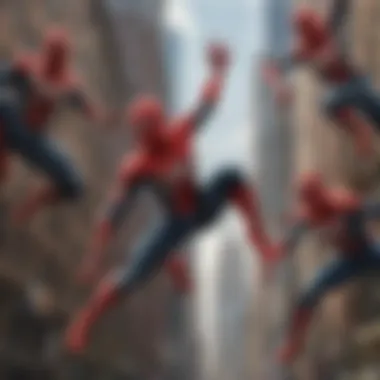The Evolution of Spider-Man: A Cinematic Journey from Tobey Maguire to Tom Holland


Spider-Man Character Analysis
Spider-Man, a beloved superhero in pop culture, has a rich history that stems from his creation by Stan Lee and Steve Ditko. The character made his debut in 'Amazing Fantasy' #15 in 1962, captivating readers with his relatable alter ego, Peter Parker, and his arachnid-like abilities. Known for his agility, web-slinging prowess, and enhanced senses, Spider-Man navigates the bustling city of New York, battling villains and upholding justice. Over the years, Spider-Man's evolution has seen various adaptations across comics, television, and especially movies, which have redefined the character for new generations.
Powers and Abilities
Spider-Man's powers are a result of a radioactive spider bite that granted him incredible abilities. His superhuman strength allows him to lift heavy objects and overpower foes, while his agility enables him to move swiftly and perform acrobatic feats. Spider-Man's web-shooters are iconic, allowing him to swing across buildings and ensnare adversaries with webbing. Furthermore, his 'spider-sense' grants him heightened awareness of danger, aiding him in combat situations. These powers, coupled with his intellect and determination, make Spider-Man a formidable and versatile hero in the Marvel Universe.
Character Development
Spider-Man's character development is a core aspect of his narrative journey. From his humble beginnings as a high school student grappling with newfound abilities to his later challenges as a mature hero balancing personal life and crime-fighting, Peter Parker's growth is a central theme. Overcoming loss, betrayal, and self-doubt, Spider-Man emerges as a symbol of resilience and altruism, learning valuable lessons about power and responsibility along the way. Notable moments, such as the loss of Uncle Ben and mentorship from figures like Tony Stark, shape Spider-Man's evolution, highlighting the complexity and depth of his character.
Introduction
Brief History of Spider-Man
Spider-Man's transition from comic books to the big screen marks a significant chapter in the superhero genre's cinematic evolution. The adaptation of Spider-Man's source material presents both challenges and opportunities for filmmakers, requiring a delicate balance between honoring the character's origins and creating a fresh, engaging narrative for modern audiences. This journey from page to screen illuminates the character's enduring appeal and the dynamic storytelling possibilities that the superhero genre offers. The adaptation of Spider-Man from Comic Books to the Big Screen serves as a testament to the character's timeless relevance and showcases the adaptability of comic book narratives in a visual medium.
Tobey Maguire's Spider-Man Era
In the realm of recent Spider-Man movies, the era of Tobey Maguire holds a significant position. This section unveils the critical role played by Maguire in shaping the iconic character of Spider-Man on the silver screen. From the release of the first Spider-Man movie to his final portrayal, Tobey Maguire brought a depth and emotional resonance to the character that resonated with audiences worldwide. His interpretation of Spider-Man not only captured the essence of the comic book hero but also paved the way for future adaptations to draw inspiration from his nuanced portrayal.
The Original Spider-Man Trilogy
Character Portrayal and Success
Delving into the specifics of character portrayal, Tobey Maguire's rendition of Spider-Man epitomized the perfect blend of vulnerability and heroism. Maguire's ability to depict Peter Parker's internal struggles and moral dilemmas set a new standard for superhero portrayals. The success of the original Spider-Man trilogy can be attributed to Maguire's portrayal of a relatable and multifaceted protagonist whose journey from an ordinary high school student to a formidable superhero struck a chord with audiences of all ages. The nuanced approach to character development, emotional depth, and on-screen charisma contributed significantly to the enduring legacy of Tobey Maguire's Spider-Man.


Legacy of Tobey Maguire
Expanding beyond the screen, Tobey Maguire's Spider-Man left an indelible mark on subsequent adaptations of the character. His interpretation influenced the narrative direction and character development of future Spider-Man iterations, setting a precedent for exploring the humanity behind the mask. The legacy of Tobey Maguire's Spider-Man resonates in the portrayal of Peter Parker as a flawed yet endearing hero, grappling with personal sacrifices and the weight of responsibility. This influence continues to shape the essence of Spider-Man in contemporary cinema, showcasing the enduring impact of Maguire's portrayal on the larger superhero genre.
Andrew Garfield's Spider-Man Revamp
The Amazing Spider-Man Series
Reimagining the Origin Story:
The decision to reimagine Spider-Man's origin story in 'The Amazing Spider-Man' series marked a bold departure from previous narratives. By delving into Peter Parker's past in a more detailed and contemporary light, the filmmakers aimed to provide audiences with a deeper insight into the character's motivations and struggles. This reimagining not only offered a fresh perspective on familiar events but also allowed for greater emotional depth and character exploration. The key characteristic of this approach lies in its ability to humanize Spider-Man, portraying him as a relatable and flawed hero, thus resonating with audiences on a personal level. While some purists may have questioned the need for revisiting the origin story, the reimagining added layers of complexity to the character, enriching the overall Spider-Man narrative.
Critical Reception
Challenges Faced by Garfield's Spider-Man:
One of the notable challenges faced by Andrew Garfield's Spider-Man was establishing a unique identity in a saturated superhero genre. Amidst comparisons to previous portrayals and high audience expectations, Garfield's interpretation had to navigate a fine line between homage and innovation. The key characteristic of these challenges was the balancing act between honoring the character's legacy and infusing new energy into the role. While Garfield's performance received praise for its authenticity and vulnerability, some critics pointed out inconsistencies in the storyline and character development. The unique feature of these challenges lay in their contribution to shaping the trajectory of the Spider-Man franchise, setting the stage for future adaptations to learn and grow from these experiences.
Tom Holland's Spider-Man in the Marvel Cinematic Universe
Introduction of Spider-Man in the Marvel Cinematic Universe
Collaboration with Other Superheroes
The integration of Spider-Man into the Marvel Cinematic Universe ushered in a new era of collaboration with other superheroes, creating dynamic interactions and team-ups that enthralled audiences globally. Spider-Man's involvement in major ensemble films such as 'Avengers: Infinity War' and 'Avengers: Endgame' brought a fresh dynamic to the superhero ensemble, showcasing his unique powers and personality amidst established Marvel icons. The synergy between Spider-Man and characters like Iron Man and Captain America not only enriched the narrative tapestry of the MCU but also laid the groundwork for future storylines and character arcs. This collaborative approach not only provides thrilling action sequences but also adds emotional depth and complexity to Spider-Man's journey within the larger Marvel universe.
Character Development and Growth


Embracing the High School Spider-Man
One of the key aspects of Tom Holland's Spider-Man portrayal is his authentic depiction as a high school student grappling with superhuman abilities and the challenges of adolescence. Embracing the high school setting brings a fresh and relatable dimension to Spider-Man, showcasing his struggles with balancing heroics, school life, and personal relationships. This grounding in the high school experience not only humanizes Spider-Man but also adds layers of growth and maturation to his character arc. Holland's portrayal captures the essence of a young hero navigating the complexities of both teenage life and superhero responsibilities, resonating with audiences on a deeper level.
Integration with Avengers
Impacts on the Larger MCU Storyline
The integration of Spider-Man into the Avengers roster has had significant impacts on the larger MCU storyline, shaping pivotal events and character dynamics within the cinematic universe. Spider-Man's alliances and conflicts with the Avengers have influenced the overarching narratives of the MCU, leading to consequential plot developments and character evolution. His interactions with key Avengers members have not only fueled engaging team dynamics but also contributed to the overarching themes of unity, sacrifice, and heroism woven throughout the MCU. Spider-Man's integration with the Avengers serves as a cornerstone in the intricate web of interconnected storylines that define the Marvel Cinematic Universe, enriching the tapestry of narratives and character motivations.
Comparative Analysis of Spider-Man Portrayals
Importance of Comparative Analysis of Spider-Man Portrayals
Understanding the transition of Spider-Man through different cinematic renditions is critical to grasp the character's evolution on the big screen. By conducting a comparative analysis of Spider-Man portrayals, we unravel the various interpretations of this iconic superhero character, shedding light on the distinct characteristics and narrative choices that have shaped his on-screen persona. Exploring the deviations in themes, character arcs, and visual styles allows us to appreciate the diverse complexities of Spider-Man across different movie adaptations. This analysis provides valuable insights into the creative decisions taken by filmmakers and the reception of these changes by audiences, highlighting the significance of dissecting Spider-Man's cinematic journey for a comprehensive understanding of his cinematic legacy.
Themes and Tonal Shifts
Exploring Different Tones in Spider-Man Movies
Diving into the realm of Spider-Man movies, one cannot overlook the striking shifts in themes and tones manifested across various iterations. The exploration of different tones in these movies constitutes a pivotal aspect of understanding the character's multifaceted nature and the evolving storytelling techniques employed by filmmakers. From somber undertones of introspection to lighthearted moments of wit and humor, each tonal shift contributes uniquely to the overarching narrative structure of Spider-Man films. The incorporation of diverse tones not only enriches the audience's viewing experience but also demonstrates the versatility and adaptability of the Spider-Man character to diverse cinematic contexts. While these tonal shifts introduce variety and nuance to the storytelling, they also pose challenges in maintaining a cohesive identity for the character, necessitating a delicate balance between gravitas and levity throughout the movie. Overall, exploring the tonal diversity in Spider-Man movies offers a deeper insight into the complexities of character portrayal and narrative construction, enriching the cinematic landscape with a spectrum of emotional resonances.
Audience Reception
Which Spider-Man Version Resonated the Most?
Analyzing the audience reception of different Spider-Man versions provides invaluable insights into the preferences and expectations of viewers regarding the portrayal of this beloved superhero. Understanding which Spider-Man iteration resonated the most with audiences entails delving into the factors that have influenced public perception, ranging from lead actors' performances to scriptwriting choices and thematic resonances. By examining the reception of each Spider-Man version, we unravel the audience's emotional investment in the character's journey, identifying key moments or decisions that have left lasting imprints on viewers' minds. Moreover, determining the most resonant Spider-Man version sheds light on the enduring appeal of specific narrative elements or character traits, showcasing the enduring legacy of Spider-Man across different cinematic interpretations. While audience reception serves as a barometer of success for filmmakers, it also mirrors the societal shifts and cultural sensibilities that shape viewers' cinematic preferences over time. Moreover, evaluating the audience's favorite Spider-Man version offers critical feedback for future adaptations, guiding creative directions to align with audience expectations and storytelling preferences.


Future of Spider-Man on the Big Screen
Introduction
As we gaze into the horizon of cinematic marvels, the trajectory of Spider-Man's future on the big screen becomes an enthralling focal point. The ever-evolving landscape of superhero narratives and audience expectations intertwine to shape the forthcoming exploits of our friendly neighborhood web-crawler. In this exploration, we dissect the implications and possibilities that lie ahead for Spider-Man as a cinematic icon.
Upcoming Spider-Man Projects
Into the Spider-Verse Sequel and Other Spin-offs
Embark on a journey beyond the realms of conventional storytelling with the much-anticipated 'Into the Spider-Verse Sequel and Other Spin-offs.' This project represents a daring leap into multiversal narratives, challenging the very fabric of traditional superhero storytelling. As Spider-Man ventures into uncharted territories, audiences are poised to witness a narrative spectacle that defies convention.
The key allure of 'Into the Spider-Verse Sequel and Other Spin-offs' lies in its ability to transcend linear storytelling, weaving a tapestry of interconnected universes that redefine the boundaries of Spider-Man's adventures. This innovative approach not only invigorates the Spider-Man lore but also paves the way for a new era of storytelling possibilities in the superhero genre.
Furthermore, the unique feature of embracing multiple Spider-Personas within a single narrative offers a distinct advantage in expanding the Spider-Man mythos. By exploring diverse iterations of the character across dimensions, 'Into the Spider-Verse Sequel and Other Spin-offs' creates a rich tapestry of storytelling that resonates with both ardent fans and casual viewers alike.
Possibilities for Spider-Man Storylines
Exploring New Narratives and Villains
Delve into uncharted territory as we unravel the enigmatic realm of 'Exploring New Narratives and Villains' within the Spider-Man universe. This endeavor signifies a bold exploration into unexplored story arcs and antagonists, injecting a fresh perspective into Spider-Man's mythos.
The pivotal characteristic of 'Exploring New Narratives and Villains' lies in its capacity to revitalize the Spider-Man narrative through compelling storylines and formidable adversaries. By delving into uncharted narratives, the Spider-Man franchise stands poised to captivate audiences with innovative plotlines and dynamic character arcs.
Moreover, the unique feature of introducing new villains and storylines presents a myriad of advantages for the franchise. By reinventing classic adversaries and forging new alliances, 'Exploring New Narratives and Villains' injects a sense of intrigue and unpredictability into Spider-Man's cinematic journey, ensuring a cinematic experience that defies expectations.
Conclusion
Impact of Spider-Man Evolution
On Pop Culture and Audience Expectations
The Impact of Spider-Man Evolution on Pop Culture and Audience Expectations is a critical aspect to consider when exploring the character's journey in recent movies. Spider-Man's evolution transcends mere entertainment, making a profound impact on popular culture and setting new benchmarks for cinematic storytelling. As one of the most iconic superheroes in history, Spider-Man's on-screen evolution influences audience expectations for superhero films, character development, and narrative complexity. The enduring appeal of Spider-Man lies in his relatability and humanity, resonating with viewers of all ages and backgrounds. By continuously reinventing the character, filmmakers have the opportunity to challenge conventions, explore new themes, and push the boundaries of storytelling. The interplay between Spider-Man's evolution and audience expectations creates a dynamic dialogue between creators and consumers, shaping the future of superhero cinema with each incarnation of the web-slinger.







